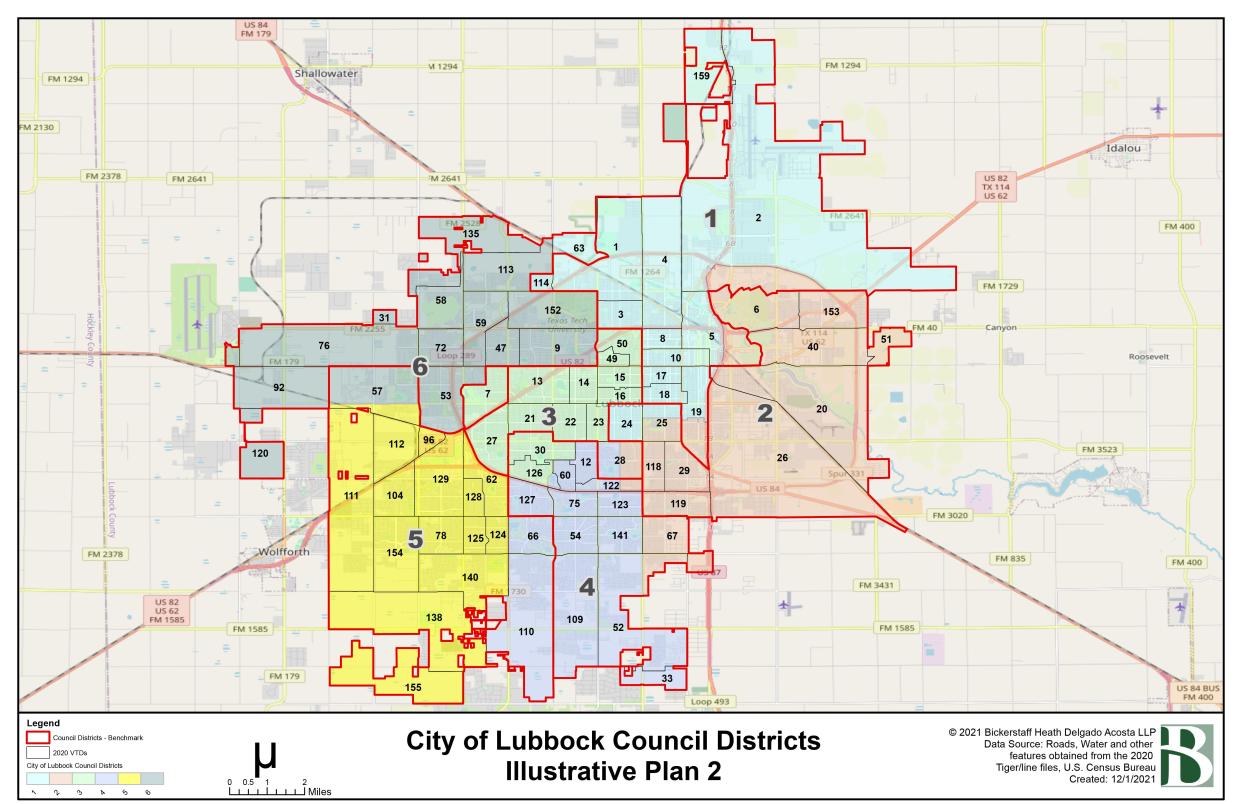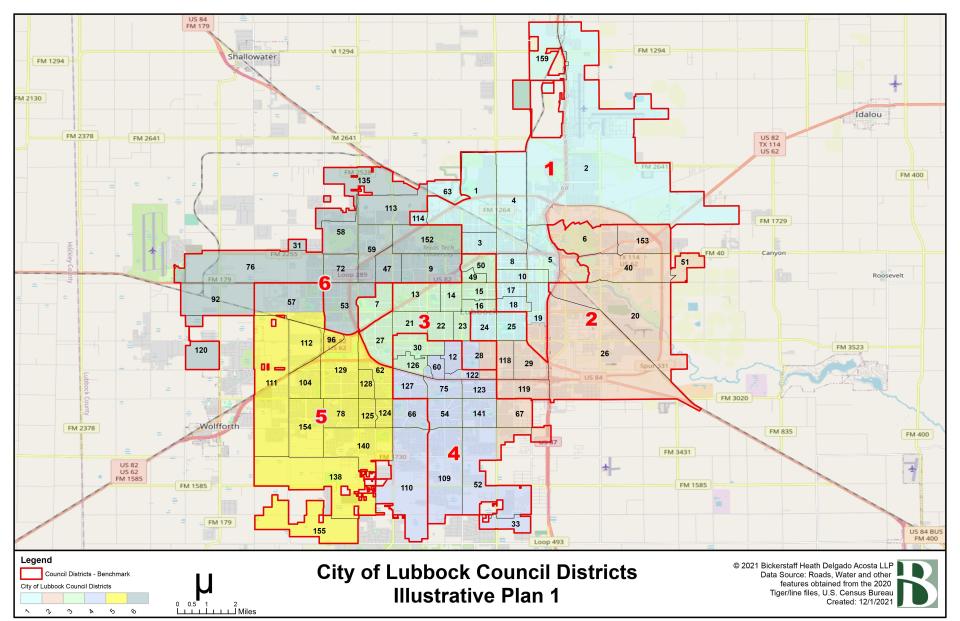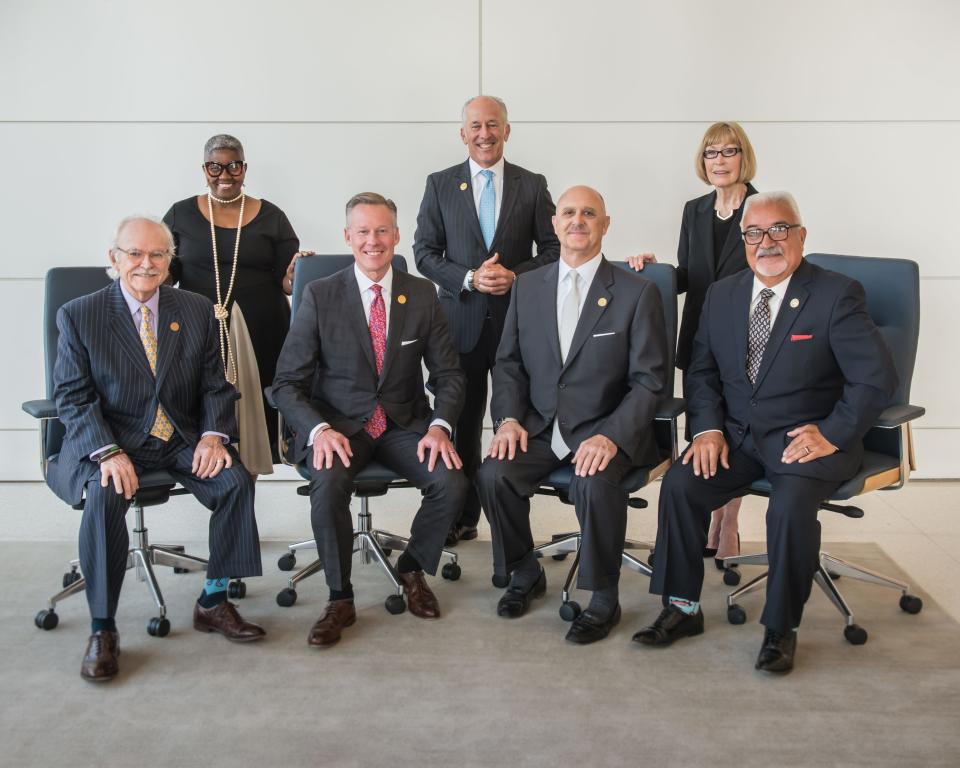Mapping out the future: Lubbock leaders weigh shifts, demographics ahead of redistricting vote

Lubbock's City Council this week is set to take a first public vote on redrawn council district maps based on data from the 2020 Census.
During its regular meeting at 5 p.m. Tuesday at Citizens Tower, the council will consider a redistricting plan for City Council Member Districts, with numerous council district boundary line adjustments prompted by population growth and shifts over the last decade. If they approve a map Tuesday, the council will consider it for a second and final reading at their next meeting Dec. 14.

The vote will come after council members hosted several public work sessions and gathered public comments as they vetted numerous map options - and their potential impacts on neighborhoods and minority/majority representation - presented by a hired consultant.
During a work session last Tuesday at Citizens Tower, councilmembers worked with the consultant to create two proposed maps they're set to consider during another work session Tuesday, Dec. 7 ahead of the regular council meeting.
David Mendez of Bickerstaff Heath Delgado Acosta LLP, who was hired as a redistricting consultant for the city, made presentations to the council twice last month, going over potential changes to the boundaries of the city's six council districts.
Many of the changes are driven by shifts in the city's population, with considerations being paid to changing demographics to maintain equitable minority-majority representation.
The 2020 Census showed the city of Lubbock's population increased to 257,141 - up 27,568 people, or 12%, from the 2010 Census.
During Tuesday's work session, Mendez said that, based on 2020 Census data that was released over the summer, the ideal size for council districts would be 42,914. Federal law mandates each district not have a more than 10% deviation from that average or ideal number to help ensure all citizens are equally represented.
But the city's growth has not been uniform, with southern and western portions of the city seeing larger gains. For example, the current District 5 in southwest Lubbock has about 56,498 people while south-central District 4 has 47,338 compared to 36,709 in District 2 in east Lubbock and 38,420 in north Lubbock's District 1.
Districts 1 and 2, along with central Lubbock's District 3, are all majority minority districts, with the Hispanic population accounting for just over half of people in 1 and 2, and the Black population accounting for about 22.4% of District 2.
"We worked through trying to protect the minority-majority nature of those districts, and that has been the challenge throughout the project," Mendez told the council.
Councilman Jeff Griffith, whose central-Lubbock-based District 3 also saw slower growth compared to western and southern portions of the city, said he believes it's important that the maps are designed to get ahead of projected population growth in the coming years.
"It's so important that we don't end up with a worse problem in five to 10 years," Griffith said.
Some of the discussion focused on the placement of territory northwest of Slide Road and the Marsha Sharp Freeway east of West Loop 289, with proposals to include it in either District 3 or District 6. Ultimately, two proposed maps the council is considering - which are shared on the city secretary's website - split that area between the districts.

Councilwoman Latrelle Joy, who represents northwest Lubbock's District 6, said a major goal for the redistricting process was to keep neighborhoods and areas with similar dynamics and goals together.
District 2 Councilwoman Shelia Patterson Harris and District 1 Councilman Juan Chadis also focused on portions of the boundary between their districts in north Lubbock, with both ultimately joining fellow council members in pushing to move forward with the two proposed maps for further consideration Tuesday.
Several of the citizens who spoke during citizens comments during work sessions in November emphasized that city leaders should ensure districts are drawn to help minority representation in minority-majority areas.
Clyde James, a resident in the South Overton neighborhood, said he hoped to see a map for his area - which is in District 1 - that brought few changes and didn't dilute the minority population of the district.
"It seems to me that this one meets that criteria," he said of the maps being presented during Tuesday's work session.
District 5 Councilman Randy Christian said that, along with approving a map that meets criteria, he's hopeful city leaders can continue working to encourage growth and development in northern and eastern portions of the city.
"My biggest concern is for us to figure out ways that we can have more people moving in to District 1 and 2," Christian said. "I think that as a council our focus has been on that in a lot of areas and that we will see those numbers move up in the next 10 years.
Total | 257,141 | 27,568 | 12.0% |
White | 152,995 | -21,019 | -12.1% |
Black | 26,083 | 6,436 | 32.8% |
American Indian | 2,779 | 1,081 | 63.7% |
Asian | 9,423 | 3,864 | 69.5% |
Pacific Islander | 217 | 45 | 26.2% |
Other Race | 29,984 | 7,284 | 32.1% |
Two or More Races | 35,660 | 29,877 | 516.6% |
Hispanic | 91,545 | 17,920 | 24.3% |
This article originally appeared on Lubbock Avalanche-Journal: Lubbock leaders weigh shifts, demographics ahead of redistricting vote

